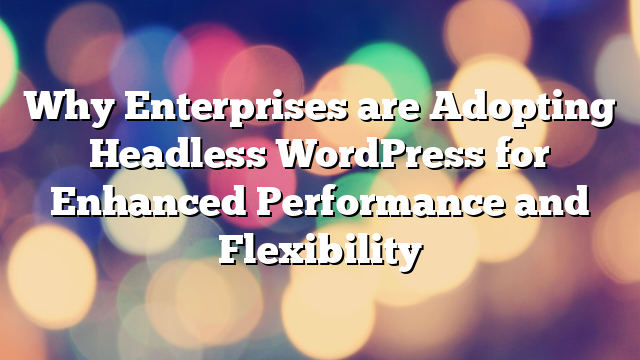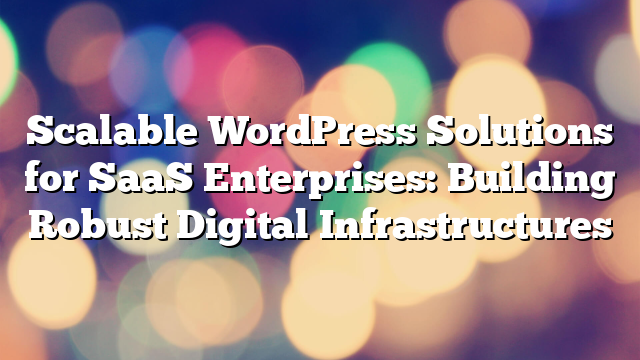Why Enterprises are Adopting Headless WordPress for Enhanced Performance and Flexibility
For enterprises looking to adopt headless WordPress, it’s essential to work with a team of experts and develop a comprehensive plan that addresses technical complexities, ongoing maintenance, and content distribution strategies. If you’re ready to enhance your enterprise website with headless WordPress, contact AllWebDev to learn more about our customized headless solutions.
13.11.2024

As digital experiences become increasingly dynamic and multi-channel, enterprises are turning to headless WordPress to meet growing demands for flexibility, speed, and scalability. Unlike traditional WordPress setups, headless architecture decouples the front-end and back-end, enabling developers to build highly customized front-ends that can deliver content across various platforms. This article explores why enterprises are shifting to headless WordPress and how it benefits their operations.
What is Headless WordPress?
Headless WordPress separates the content management system (CMS) from the front-end presentation layer. In a headless setup, WordPress manages content while a front-end framework, such as Next.js, React, or Vue.js, handles the website’s display. WordPress serves as the content API, delivering data to any front-end or device that requests it, including mobile apps, smart devices, or other websites.
This approach allows developers to utilize WordPress’s robust content management capabilities while building highly customized front-end solutions tailored to enterprise needs.
Benefits of Headless WordPress for Enterprises
1. Enhanced Performance and Speed
Headless WordPress allows for faster page loads and improved site performance. By decoupling the front-end, developers can leverage JavaScript frameworks that load content asynchronously and minimize server requests. This approach enhances user experience, especially for high-traffic sites where speed is critical to reducing bounce rates and improving engagement. Enterprise websites benefit significantly from optimized performance, providing visitors with a seamless browsing experience.
2. Flexibility in Front-End Design and Development
Enterprises often require highly customized front-end solutions to differentiate themselves in competitive markets. With headless WordPress, front-end developers have the freedom to design unique user interfaces without being limited by WordPress’s PHP-based theming. They can use modern JavaScript frameworks like React or Vue to create engaging, responsive designs that offer consistent experiences across devices.
This flexibility enables enterprises to build websites tailored to specific brand identities and user journeys, enhancing both aesthetics and functionality.
3. Multi-Channel Content Distribution
Headless WordPress allows content to be distributed across various channels, from websites to mobile apps, digital kiosks, IoT devices, and more. For enterprises operating in multiple regions or platforms, this multi-channel capability is invaluable. The WordPress back-end serves as a content repository, which can be pushed to any front-end experience, streamlining the content management process and maintaining consistency across all touchpoints.
This feature is particularly advantageous for enterprises aiming to reach audiences across diverse digital landscapes, ensuring that content remains accessible and consistent everywhere it appears.
4. Improved Scalability
Scalability is essential for enterprise websites that experience large volumes of traffic or rapid growth. Traditional WordPress setups can become bottlenecked by increased load demands, but headless WordPress enables better scalability by leveraging cloud hosting solutions and serverless front-ends. Front-end frameworks are designed to handle high loads and can be distributed across Content Delivery Networks (CDNs) to reduce latency and accommodate traffic spikes.
For enterprises, this means that their websites can handle increased user loads without sacrificing performance, making headless WordPress an ideal choice for scalable architecture.
5. Enhanced Security
Headless WordPress can offer improved security by limiting direct access to the CMS. Since the front-end and back-end are decoupled, sensitive data is more secure as it’s harder for malicious users to access. Additionally, exposing only the API to the front-end reduces the risk of direct attacks on the website’s core files.
For enterprises handling sensitive data or operating in regulated industries, this added layer of security provides significant peace of mind and reduces the likelihood of cyber threats impacting critical content management systems.
Key Considerations When Adopting Headless WordPress
1. Technical Complexity and Development Expertise
Headless WordPress requires a higher level of technical knowledge than traditional WordPress setups. Developers must be familiar with JavaScript frameworks, APIs, and front-end technologies. Enterprises considering headless architecture should assess whether their development team has the expertise required to manage this complexity or if they need to invest in external resources.
2. Customization of the Publishing Experience
While headless WordPress enhances front-end flexibility, it may require additional customization in the CMS to support non-standard workflows. For example, previewing content as it appears on the front-end can be challenging. Solutions like custom plugins or headless CMS tools can help bridge this gap, but enterprises must ensure that the authoring experience aligns with their publishing needs to maintain productivity.
3. API Limitations and Third-Party Integrations
As headless WordPress relies on APIs, understanding API limitations is crucial. Large enterprises often integrate multiple third-party services, which may require custom development to align with API capabilities. When planning a headless WordPress site, it’s important to consider how various integrations will work with the CMS and to anticipate potential limitations in data transfer between platforms.
Implementing Headless WordPress Successfully
1. Choose the Right Front-End Framework
The front-end framework you choose will affect the site’s performance, capabilities, and development time. Next.js, for example, is popular for its server-side rendering capabilities, which enhance SEO and performance. Vue.js and Gatsby are also viable options, each offering unique benefits that can meet specific enterprise needs. Selecting a front-end framework that complements your business objectives and technical requirements is essential for a successful headless implementation.
2. Partner with an Experienced Development Team
Implementing a headless WordPress site requires specialized skills, particularly in modern JavaScript frameworks and API integration. Partnering with a team experienced in headless architecture can simplify the development process, reduce errors, and ensure optimal performance. A knowledgeable development team will guide you in choosing the best practices, frameworks, and configurations for a seamless deployment.
3. Plan for Ongoing Maintenance and Scaling
While headless WordPress offers improved scalability, it also requires ongoing maintenance to ensure smooth performance. Regularly monitoring API performance, updating front-end frameworks, and managing server resources are necessary to keep your website running at peak efficiency. For enterprises anticipating rapid growth, establishing a maintenance plan for both front-end and back-end systems is essential to maintain performance and user satisfaction.
Conclusion
Headless WordPress is an increasingly popular solution for enterprises seeking a scalable, flexible, and high-performing digital experience. By decoupling the front-end and back-end, enterprises can deliver rich, consistent experiences across multiple channels while enjoying the benefits of enhanced speed, security, and customization.
For enterprises looking to adopt headless WordPress, it’s essential to work with a team of experts and develop a comprehensive plan that addresses technical complexities, ongoing maintenance, and content distribution strategies. If you’re ready to enhance your enterprise website with headless WordPress, contact AllWebDev to learn more about our customized headless solutions.



